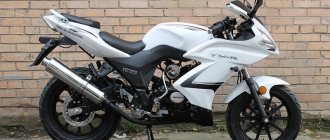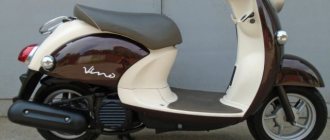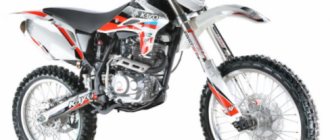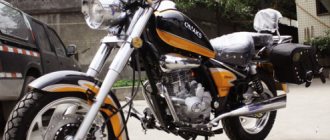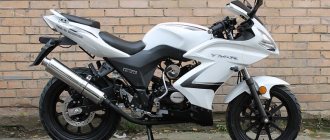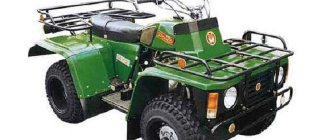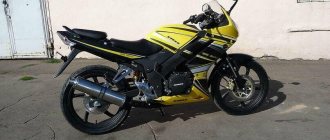Pros and cons of Yamasaki Skorion
Advantages
- Abundance of tuning. For example, the 50cc Yamasaki Scorpion YM50 8A, like its 125cc brother, can be easily converted into a 150cc bike. This, of course, will not turn them into a rocket, but their agility will noticeably increase.
- Low price. It won’t be easy to find something cheaper, but a used Scorpio can even be purchased for several tens of thousands of rubles.
- Versatility of spare parts and consumables. Almost everything you need can be picked up in any store that sells spare parts for Chinese scooters and motorcycles.
- Weight. Yamasaki Scoprion 3 or 4 weighs only about 100 kg, like their previous modifications. Physically, handling a moped is very easy.
Flaws
- Build quality. There are the most complaints about it - even on new mopeds, something regularly unscrews and falls off. To be fair, we note that this depends on the integrity of the particular dealer. Some of them still fine-tune the equipment before handing it over to the buyer.
- Too archaic transmission. KPP-4 in the 21st century - are you serious?
- Weak brakes. There is nothing to say about the rear “drum”, but even the front disc brake is of little use.
- Uncomfortable landing. The moped is clearly designed for compact Chinese, and not for physically larger Europeans.
- Extremely weak light from the headlight. On unlit roads at night you feel extremely insecure on the Yamasaki Scorpion, because the power of the headlight is comparable to that of a flashlight.
Manual and operation of Chinese scooters Scorpion, Mantis, Rapiras
Scooters “SCORPION”, “RAPIRAS”, “MANTIS”, “FEVER”, “CYBER” are a convenient, easy-to-use vehicle that combines ease of use, maneuverability, comfort and reliability. Thanks to the presence of an electric starter, automatic continuously variable transmission, low weight and low center of gravity, operating a scooter does not require much physical effort and long training.
Please read this manual carefully and only operate your scooter if you are absolutely sure that you have understood all the information contained in it. The instruction manual includes brief information on the structure of the scooter, the principles of operation of its components and assemblies, information necessary for the correct operation of the scooter, as well as technical specifications.
This manual should be considered an integral part of the scooter and should always be with the scooter, even if it is resold. Product service life is 5 years.
When operating a scooter, you should always remember safety precautions so as not to cause harm to yourself and others. Please study carefully and strictly follow the following recommendations.
1. Safety measures when operating a scooter.
In accordance with current legislation, a citizen who has reached 16 years of age is allowed to drive a scooter. The presence of a protective motorcycle helmet on the head of the driver and passenger is mandatory.
Before each trip, you need to check the technical condition of the scooter. If you are unwell or have consumed alcohol or medications that reduce the reaction rate the day before, you should refuse to travel. It should be remembered that even a small amount of alcohol consumed sharply reduces the driver’s reaction time, and therefore the safety of him and those around him.
When riding a scooter, it is recommended to wear appropriate safety clothing:
- protective helmet, goggles;
- leather gloves and low-heeled shoes;
- tight-fitting clothing made of leather or thick fabric with reflective elements;
When traveling, try not to wear clothes that are too long or loose with hanging elements (long or wide coats, skirts, etc.), because... this could result in a serious accident.
When the engine is running, the muffler and other parts of the exhaust system become very hot and remain hot for some time after stopping. Do not touch them and avoid contact of exhaust system parts with flammable materials.
Park the scooter away from dry grass and flammable substances.
Do not exceed limits and restrictions regarding break-in conditions, maximum speed and load, brake pad wear, tire pressure and tread wear. Strictly follow the traffic rules, take into account weather conditions and your scooter driving skills.
Be especially careful when driving on wet roads, as this increases the braking distance and the risk of skidding.
The design of the scooter fully complies with the safety standards in force on the day of production and the standards for the content of harmful substances in exhaust gases.
To ensure that your scooter continues to meet environmental and safety requirements, perform maintenance according to the schedule and instructions provided in this manual and in cooperation with your dealer or an authorized service station.
4.1 instruction manual with warranty and service cards – 1 pc.; 4.2 set of tools – 1 set; 4.3 ignition key – 2 pcs.; 4.4 alarm remote control – 2 pcs.
Specifications
Front wheel brake lever. By pressing the lever, the front wheel brake is activated and the brake light comes on. The throttle control is used to regulate speed.
To increase the speed, turn the handle toward you, to decrease the speed, turn it away from you or release it (in this case, the throttle will move under the action of the spring to the position corresponding to idling).
What engine does the yamasaki scorpion have?
The author has never sat on any vehicle with a motor other than his own! So, the 2021 season ended with the engine packed and the bike in the trunk. Probably the logical solution would be to save some money and buy a category A license? But... I didn’t do that)
But we know that it’s also in the head! The head was thoroughly redesigned. And when I say redesigned, I really mean redesigned) The cylinder head was sawed/built up by comrade Nebero at the stand)! Channels 21/18 (+3mm), valves 24/21 (+1 to the drain), 4 chamfers on the inlet, 3 on the exhaust, the drain channel from the 70cc cylinder head was completely reprofiled (110 was terribly blown, worse than the 70, a fellow tuner actually recommended it throw it away)
The body of the intake channel was built up along the lower edge with a special compound; the channel is not round for working with a side intake (for purging, but there is no other way to fit a large carb with a normal length of the manifold). Photographs of the heads from takegawa head r were taken as a basis, and this is, for a minute, 17 forces from the same volume (stock 106, by the way, gives about 7 forces). The head is blown from 1mm to 10.5 (stock springs are limited) much better than stock, it won’t reach 20 horses, but such a cylinder head will let 17 through itself!
Curve channel specifically for the side position of the carb About the result
If anyone has a free milling machine, then I am ready to pay for the manufacture of the shaft according to my drawings!)
45, and there is an easy way to do this by simply increasing the length of the modulator. The ignition works there very simply - the beginning of the modulator curtain is position XX = 8 degrees. The end is the optimal position for 3500 rpm = 26. But since There are only two positions, then by shifting the gearbox for rpm, there is a high chance of running into detonation in the middle range (What the hell did you want from 45 degrees at 4k rpm)? The option with a block capable of dispensing UOS not linearly, by analogy with injection cards, I did not have time to finish. But I am 200% sure that this one action would give an increase of 15-20% to the current figures.
(I’d like to screw a phase shifter here... If I had it, I could start from the second one, and in gymkhana the moped wouldn’t stall on the dead ends, we should invent it, or what?)
I tried to balance my knee using a book I found on the Internet, if I’m not mistaken the coefficient was 0.7. Result? But it’s not there... Either the calculations are for a vertical motor and not a horizontal one, or I’m a fool, but the skis don’t work! The vibration disappears completely somewhere around 6500 (range ± 200 rpm!), or when the gas is released.
Total: Crankshaft-1500 CPG-1500 modification of cylinder head-500 (sent back and forth) split gear-0 Carburetor-1200 Intake tract-250 Time spent - about 20 man hours Yes, for another 100 bucks I definitely bought happiness) And as a result , at least QUADURING power at the rear wheel and a crazy smile all season long)! Is it possible to make a motorcycle out of a moped? - NO Is it possible to make a 50k go around Chinese 150s? - YES If you have an ignition control unit, you can compete with the 250, they are made painfully crookedly!
As a result, Gadzilla traveled more than 3k kilometers, and in full health went to winter quarters, and his creator thought that the equivalent of the Chinese 200k was already too small for him and... Is it possible to do something about this?
Source
SCORPION 50
Scooter SCORPION 50 Operating Manual
When purchasing a scooter, carefully check:
1. The seller has filled out the pre-sale preparation coupon correctly and completely, indicating the date of sale and the names of the organizations that carried out the pre-sale preparation and sale. 2. Correspondence of the frame and engine numbers on the scooter and in the pre-sale preparation coupon. The scooter identification number is stamped on the front bend of the frame; The engine serial number is stamped on the left side of the engine crankcase. 3. The presence in the pre-sale preparation coupon of seals or stamps and signatures of representatives of the trading organization and the organization that carried out the pre-sale preparation. 4. Complete set - each scooter is supplied with: 4.1 instruction manual with warranty and service cards - 1 pc.; 4.2 set of tools – 1 set; 4.3 ignition key – 2 pcs.; 4.4 alarm remote control – 2 pcs.
Specifications
| Scooter base | 1300mm |
| Dimensions (L/W/H) | 1870/702/1160 mm |
| Ground clearance | 110 mm |
| Weight (dry) | 90 kg |
| Maximum load | 90 kg |
| Maximum speed | 66 km/h |
| Engine | 4-stroke, single-cylinder, forced air cooling |
| Cylinder displacement | 50 cm3 |
| Starting system | electric and kick starter |
| Lubrication system | closed, with oil pump |
| Ignition system | contactless, capacitor |
| Fuel | gasoline with an octane number of at least 90 |
| Oil | motor oil for four-stroke engines SAE 15 W/40 |
| type of drive | V-belt variator |
| Clutch | automatic centrifugal |
| Front suspension | telescopic fork |
| Rear suspension | Engine-transmission unit with two shock absorber struts |
| Tires (front/rear) | 120/70-12 |
| Brakes (front/rear) | disc/drum |
| Accumulator battery | 12 volts, 7 amp hours |
| Generator | flywheel, AC, permanent magnet, 115 W |
| Fuse | 10 A |
| Candle | LD A7 RTC or NGK: C7 HSA |
| Gas tank | 5 l. |
| Crankcase | 0.9 l. |
| Gear housing | 0.15 l. |
Location of main components
| Left view | Right view |
| 1. gas cap 2. seat lock 3. spoiler 4. side support 5. center stand 6. kick starter pedal 7. air filter | 1. front turn signal 2. ignition switch 3. battery cover 4. tail light 5. engine 6. muffler |
Controls and instruments
Rear wheel brake lever. By pressing the lever, the rear wheel brake is activated and the brake light comes on. Front wheel brake lever. By pressing the lever, the front wheel brake is activated and the brake light comes on. Throttle control handle. The throttle control is used to regulate speed. To increase the speed, turn the handle toward you, to decrease the speed, turn it away from you or release it (in this case, the throttle will move under the action of the spring to the position corresponding to idling). Egnition lock. The ignition switch has the following key positions:
all current consumers are switched off. The engine cannot be started; the key can be inserted or removed from the lock.
The ignition, electric starter, lighting, brake light, and turn signal circuits are turned on. The engine can be started, but the key cannot be removed from the lock.
all current consumers are switched off. The steering wheel can be locked; the key can be inserted or removed from the lock. To lock the steering wheel, you need to turn the steering wheel to the left, push in the key and turn it all the way to the position. To unlock the steering wheel, turn the key clockwise to the
Turn signal switch. The turn signal switch is used to turn the turn signals on and off. To turn on the indicators, move the lever to the right or left from the middle position. In this case, the lever will return to its original position, the direction indicators and the indicator lamp on the instrument panel will begin to flash. To stop the indicators, press the lever button.
Beep button. If necessary, press the button to sound a sound signal. The headlight switch has 2 fixed positions: low beam, high beam. The light switch has 3 fixed positions:
headlight, instrument panel lighting, tail light are off
instrument panel lighting, front parking light, rear light included
headlight, instrument panel lighting, tail light included
The electric starter button is used to start the engine. Turn the ignition key to position, press the rear brake lever and press the electric start button. Immediately after the engine starts, release the button.
Dashboard.
The speedometer shows the speed of the scooter (in kilometers per hour).
The odometer shows the scooter's mileage in kilometers since the start of operation. The fuel level indicator shows the amount of fuel in the tank. The arrow in the red sector indicates the need to refuel. The headlight high beam indicator light indicates that the high beam is on. The turn signal warning lamps indicate that the turn signals are turned on. Fuel cap. To open the gas tank, slide the protective cap of the lid lock in the direction of the arrow, insert the ignition key into the lock, turn the key clockwise until it stops and remove the cap from the filler neck. After refueling the scooter, install the cap in place so that the top of the triangular mark on the cap is directed to the side, perpendicular to the longitudinal axis of the scooter. In this case, the key should be turned clockwise. Press the lid firmly against the neck and turn the key counterclockwise all the way, then remove it from the lock and close the lock with the protective cap. The luggage compartment is located under the seat and has a capacity of 5 kg.
Kick starter pedal. To start the engine, fold back the foot of the kick-starter pedal, vigorously press it down with your foot, after first pressing the rear brake lever. After starting the engine, return the kick starter pedal foot to its original position.
Central stand and side support. To install the scooter on the center stand, press its foot with your foot and pull the scooter towards you by the handlebars with your left hand, while lifting the rear of the scooter by the spoiler with your right hand. To use the side support, push it all the way out to the side with your foot.
Engine starting. It is impossible to start the engine with the side support folded down. Before starting the engine, you should check the amount of fuel and engine oil and place the scooter on the center stand.
Before starting a cold engine, press the kick starter pedal 4-5 times vigorously. Then press the rear brake lever, insert the key into the ignition switch, turn it clockwise to position and press the engine start button (electric starter). Keep the rear brake lever depressed throughout the entire engine starting procedure! Release the start button once the engine has started. Do not hold it pressed continuously for more than 4-5 seconds.
Pause for 10-15 seconds before trying again. If the engine does not start after 3-4 attempts, try starting it using the kick starter while continuing to press the rear brake lever. Warm up the running engine for 1-2 minutes at idle speed. Starting a warm engine is carried out in the same way. If, when you press the start button, the engine does not start within 2-3 seconds, turn the throttle control handle 1/8–1/4 stroke. If it is impossible to start the engine using the electric starter (for example, when the battery is discharged), start the engine using the kick starter pedal. The starting procedure using a kick starter is similar to starting with an electric starter.
Maintenance.
Frequency of maintenance during the warranty period.
| Operations | 500 km (TO-1) | 1500 km (TO-2) | 3000 km (TO-3) | 6000 km (TO-4) |
| Battery | Examination | Examination | Examination | Examination |
| Fuse | Examination | Examination | Examination | Examination |
| Spark plug | Cleaning | Cleaning | Replacement | Replacement |
| Engine oil | Replacement | Replacement | Replacement | Replacement |
| Oil filter | Cleaning | Cleaning | Cleaning | Cleaning |
| Brakes | Adjustment | Adjustment | Brake pad wear monitoring, adjustment | Brake pad wear monitoring, adjustment |
| Drive belt | Examination | Examination | Examination | Check/Replace |
| Transmission oil | Replacement | Level check | Replacement | Replacement |
| Fuel hose | Examination | Examination | Examination | Examination |
| Air filter | Examination | Cleaning | Replacement | Replacement |
| Fuel filter | Examination | Examination | Examination | Replacement |
| Carburetor | Examination | Examination | Check, adjustment/td> | Checking, adjustment |
| Tires | Examination | Examination | Examination | Examination |
| Fasteners | Lift | Lift | Lift | Lift |
After completing the break-in period and passing TO-1, TO-2 and TO-3, we subsequently recommend performing work in the scope of TO-3 with a mileage interval of 3000 km.
Battery. The scooter engine is equipped with an electronic contactless ignition system, the operation of which does not require an external power source, i.e. The engine can be started with a discharged battery or even without it. However, for normal operation of lighting and alarm devices, a charged battery is required. The battery is located in a niche, under the driver's footrest; it is accessible after removing the battery compartment cover.
Your scooter may be equipped with a "maintenance free" battery or a regular, acid-acid battery with a capacity of 4 or 7 amp hours. In the first case, caring for the battery consists of keeping it charged. When installing a “maintained” battery, it is necessary to regularly monitor the electrolyte level, which should be between the upper and lower marks located on the wall of the case, and maintain its normal density, which should be 1.25...1.27 g/cm3 (with a full charge battery). The rated voltage of the battery is 12 V. When the voltage is less than 11.5 V, it is recommended to start the engine with a kick starter.
In case of a long break in the operation of the scooter, disconnect the “-” terminal from the on-board network and periodically recharge the battery with a direct current of no more than 0.5A.
Engine oil. Checking the oil level in the engine crankcase. On a horizontal platform, place the scooter on the center stand, remove the dipstick located on the right side of the engine crankcase. The oil should be at a level between the lower and upper marks of the dipstick. If necessary, add oil for four-stroke engines API SG, SH with viscosity SAE 15W 40.
Use only special oil for four-stroke engines. Do not mix different types of oils. The frequency of changing engine oil is in accordance with clause 11 “Maintenance”. Do not operate the scooter with insufficient engine oil level, as this will lead to engine failure. Change the oil in a timely manner - the reliability and durability of your scooter’s engine depends on it.
Replacing engine oil and oil filter. When draining oil from a warm engine, be careful because... it has a high temperature.
Place the scooter on the center stand and warm up the engine for 4-5 minutes. Carefully remove the drain plug located on the lower left side of the crankcase and drain the oil from the crankcase into a waste oil container. Unscrew the oil filter cap, remove the oil filter and, after checking it for damage, wash it in kerosene or washing liquid. If the oil filter is damaged, replace it with a new one. Operating an engine with a damaged or contaminated oil filter is unacceptable, as it leads to a sharp reduction in engine service life. Install a new or washed oil filter and tighten the filter cap and drain plug. Fill the engine crankcase with 900 ml of engine oil for four-stroke engines API SG, SH with a viscosity of SAE 15W 40. After 20-30 seconds. Check the oil level in the engine crankcase using the dipstick.
Brakes.
The rate of wear of the friction linings of brake pads, and therefore the need to adjust the brake drive mechanisms, directly depends on the condition of the road surface and driving style. When operating the scooter on unpaved, dusty or muddy roads, in hilly terrain, or during frequent heavy braking, the brake pad linings wear out much faster than under normal conditions, which necessitates more frequent brake adjustments and brake pad replacements.
Regularly check the condition of the friction linings of the brake pads. If the thickness of the lining in any area is less than 1.5 mm, replace the brake pad.
Front wheel disc brake maintenance.
The front wheel disc brake with hydraulic drive does not require adjustment. Inspection of brake pads is carried out without removing the wheel from the front part of the brake disc. The level of brake fluid in the master cylinder reservoir is monitored through an inspection window located on its rear wall facing the driver.
Place the scooter's handlebars in a position where the tank lid is in a horizontal position; the liquid level should be from ½ to 2/3 of the height of the inspection window. Free play, measured at the end of the front brake lever, should be between 10-20 mm. Increased free play of the lever, as well as insufficient efficiency of the front brake when it is pressed, indicate that air has entered the hydraulic system of its drive.
Air entering the hydraulic system may cause brake failure. In this case, it is necessary to bleed the hydraulic system (bleed air). Bleed air from the brake system as follows:
- Unscrew the screws and remove the brake master cylinder reservoir cover with the diaphragm;
- remove the cap from the air release valve, put a rubber tube on the valve fitting, the other end of which is immersed in a container with a small amount of brake fluid;
- press the front brake lever vigorously 3-4 times and, while holding the brake lever pressed, release it for 1-2 seconds. air release valve ¼ turn to allow air to escape from the brake system (in the form of bubbles in the brake fluid container); Without releasing the front wheel brake lever, close the air release valve;
- add brake fluid to the reservoir of the main brake cylinder, bringing its level to normal;
- repeat the operation until air is completely removed from the hydraulic system, as evidenced by the absence of bubbles in the brake fluid coming out of the tube into the container during bleeding.
- After bleeding the hydraulic system, reinstall the cap with the diaphragm of the brake master cylinder reservoir, secure it with screws, remove the tube from the air bleed valve fitting and put the cap on it.
- If it is difficult to bleed the brake system, check the reliability and tightness of the connections of the hydraulic system hoses, and if necessary, tighten the connections.
Adjusting the rear wheel brake. By rotating the adjusting nut, adjust the length of the cable so that the free play, measured at the end of the rear brake lever, is 8-15mm. When the lever is released, the wheel should rotate freely, without the brake pads touching the wheel brake drum. After completing the adjustment, make sure that the concave end of the adjusting nut fits snugly against the cylindrical surface of the pin.
Transmission oil. Checking the oil level in the gearbox. On a horizontal platform, place the scooter on the central stand, unscrew the screw plug and make sure that the oil level in the gearbox housing reaches the lower edge of the inspection hole. If the oil level is below the control hole, add gear oil of API GL-1, GL-2 viscosity classes SAE 75W, 80W/85W through the control hole using a syringe or by tilting the scooter to the right side (add in small doses, returning the scooter to a vertical position to check the level oils). The total volume of oil in the gearbox housing should be 150 cm3
Changing the oil in the gearbox
On a horizontal platform, place the scooter on the center stand, unscrew the drain plug, drain the oil completely, slightly lifting the front part of the scooter. Replace the drain plug and pour 150 cm 3 of API GL-1, GL-2 gear oil of viscosity grade SAE75W or 80W/85W through the inspection hole using a syringe or by tilting the scooter to the right side.
Basic malfunctions and their elimination
| Engine won't start |
No fuel is getting into the carburetor
| There is no fuel in the fuel tank Fuel filter clogged Fuel line is clogged, pinched or leaking Vacuum hose is leaking or vacuum valve is faulty | Fill with fuel Replace the fuel filter Remove blockages or kinks in the fuel line, replace the leaking section Eliminate leaks in the vacuum hose, repair the malfunction or replace the vacuum valve |
| The presence of fuel condensate in the engine cylinder due to excessive over-enrichment of the mixture - unscrew the spark plug and inspect the electrodes and insulator; the presence of a wet film or drops of fuel indicates over-enrichment of the mixture and precipitation of fuel condensate | Re-enrichment of the fuel mixture due to repeated sharp turns of the throttle control handle Carburetor float chamber shut-off valve leaking The air filter filter element is dirty or the air passage of the intake tract is clogged | Dry the candle. Without installing it in place, turn the throttle control handle towards you all the way, vigorously press the kick-starter pedal 10-15 times. Screw the spark plug into place, put on the high-voltage tip Grind in or replace the shut-off valve. Wash the filter element or remove the blockage in the air channel |
| There is no spark discharge between the electrodes of the spark plug - attach the tip of the high-voltage wire to the spark plug unscrewed from the cylinder head and ensure electrical contact of the spark plug body with the engine ground - turn on the ignition and check for the presence of a spark discharge in the gap between the spark plug electrodes in the starting mode using an electric starter or kick - starter - after completing the check, do not forget to turn off the ignition. The absence of a spark discharge indicates a malfunction of the spark plug or ignition system. | Faulty spark plug Faulty ignition system. | Clean and rinse the spark plug with solvent or pure gasoline, and after drying it, repeat the procedure for checking the spark discharge. If it is missing, replace the spark plug. Check the reliability of the electrical contacts and the absence of cable breaks in the ignition system circuits. If the check does not lead to a positive result, contact your dealer or authorized service station. |
| The engine starts, but stalls at idle. The carburetor idle system does not work. | The idle jet is clogged. The idle speed adjustment is broken. | Clean and blow out the calibrated hole of the idle speed jet. Adjust the idle speed. |
| The engine starts but loses power or runs rough when revving up | The air filter element is heavily contaminated. The air filter inlet pipe is partially clogged or pinched. | Wash the air filter filter element. Restore the normal cross-section of the intake tract. |
The engine does not develop the declared power and is prone to overheating
|
Scooter conservation
If the scooter is not used for a long time (in winter or for another reason), it must be preserved
- Before storing, thoroughly wash and dry the scooter.
- Fill the fuel tank with gasoline.
- Place the scooter on the center stand
- Disconnect the wires from the battery by first disconnecting the “-” terminal.
- During storage, monitor the condition of the battery in accordance with the “Battery” section.
- Remove the spark plug and pour 3-5 cm3 of engine oil into the cylinder. Press the kick starter pedal several times. Reinstall the spark plug.
- Apply a preservative lubricant to the surfaces of chrome and galvanized parts using a spray bottle or brush. Treat vinyl and rubber surfaces with a rubber preservative, and painted surfaces with an automotive preservative.
- Maintain tire pressure.
- Store the scooter in a place protected from sunlight and precipitation, away from heating devices and aggressive environments
During long-term storage, we recommend that you cover the scooter with a protective cover.
Re-preservation procedure
- Wipe down the scooter
- Remove the spark plug and press the kick starter pedal vigorously several times. Screw in the candle
- Install and connect the charged battery.
- Check the tire pressure.
- Carry out a full inspection and maintenance of the scooter in accordance with the list of works TO-1
Yamasaki Scorpio motorcycles, life of a salesman
Good day everyone, I haven’t written for a long time, I was on vacation. In this article I want to talk about the arrival of Yamasaki Scorpio motorcycles. And I want to hear your opinion.
These devices were brought to the store for us, and we were not much shocked.
Not only do they come as a designer set, but these motorcycles are sold as a YAMASAKI SCORPION car kit.
So these devices use
50cc piston engines. When customers find out about this, they arrive a little in shock, I just can’t understand why they couldn’t supply at least 110 piston ones. For example, mopeds like Alpha come, they cost fifty dollars and in addition they give hundredths of piston ones. The price tag for Yamasaki is 70,000 rubles. Of course, clients don’t want fifty-kopeck devices for that kind of money.
I think the price tag is too high, the price of such a device is no more than
45,000 rubles. because if you set at least 110 - 125 cc. The piston also needs to be changed and the head.
Source
Yamasaki Scorpion - a sub-scooter in a beautiful shell
Hmm... Chinese sportbikes... Where to start talking about the Yamasaki Scorpion? Perhaps because everyone has a mother. And most of these mothers are afraid of motorcycles, especially big ones, like fire, considering them a chariot carrying their child straight to hell. We will not overestimate the degree of threat, but I think everyone will agree that a motorcycle is a rather dangerous form of transport. What could be more dangerous than a sportbike? That's right - a Chinese sportbike.
The fact is that Chinese manufacturers traditionally occupy a very low price niche. Work and high-quality parts are expensive - what kind of performance are we talking about here? If everything is greatly simplified, then this unit looks as funny as the miracle in the photo. And sportbikes, meanwhile, are very demanding on quality, if only because if something falls off or cracks during the movement, then there is a very high probability that your wild little head will crack along with this part.
Let's go directly to the unit itself. This miracle, proudly called a motorcycle, has as much as 50 cubic meters in the engine - just like Carlson. Essentially, it's a scooter with a sports mask. However, think about it - are the Chinese the smartest and the first to think of putting it on the Yamasaki Scorpion, which is de facto a scooter, beautiful
cowl? No. Because the fairing has its own weight, which is not easy for a 50 cc engine to handle. Therefore, the speed characteristics here are off the charts - as much as 90 kilometers per hour. There are "uncool" scooters that are in the same price range, and they can easily rub his nose in the face. And the pretentious appearance is conducive to racing. However, this is strictly not recommended, because the Yamasaki Scorpion most of all looks like a muscleman who has overfed too many hormones - it seems visually strong, but in reality... Think about the blow your ego will receive after losing to some kind of scooter on such a bike. There’s even a joke abroad (photo on the right): “Oh no, I run faster anyway.”
This unit is especially popular among those who don’t have much money but want to show off. Such people love to spread rumors that say: “I saw that the godfather of my husband’s sister’s brother has shaded this beauty, and now she flies like the wind.” Of course, it is possible and even necessary to tune the Yamasaki Scorpion. However, let's return to that very beautiful sports fairing. Not only does it weigh prohibitively for this bike, but judging by the price of the whole bike, it costs absolutely nothing. This means that this part does not contain any high-quality materials that meet industry standards. Think about it, can this thing withstand high speed wind pressure? Or at least tolerate the temperature of the engine running at maximum? I think there is no need to explain that, according to the laws of physics, the strength of substances operating in extreme temperature conditions decreases.
Yamasaki Scorpion collects funny reviews - there is almost no specific information. And all because technology-savvy people who can write an adequate review do not buy this for themselves. And what exists is like the voice of one crying in the desert: “Don’t buy it!” Although, perhaps, the Yamasaki Scorpio has such reviews because they wanted a sportbike, but got a non-scooter.
In general, you can buy such a thing for yourself and drive it very carefully. But perhaps its only use is a trip to a rural club in order to dazzle girls with its splendor.
Is the game worth the candle?
Is the game worth the candle?
27 Sep 2021, 11:28
Hello everyone!) Recently I became the proud owner of a two-wheeled horse (Yamasaki Scorpion 3 moped). So I’m ready to increase the cubic capacity (now it’s 72cc). There’s a lot of information on the Internet on how to switch from 50 to 72, from 72 to 110, etc. But there are very few reviews and comparisons of the “before and after” type, basically I start everything with these words: 50cc is not enough for you (72, 110, etc.) then I begin to describe in detail the procedure for increasing volume, and what happens after the transition and the feeling of increasing cubic capacity often remains behind the scenes. Since I’m not very versed in technology, I decided for myself that if I increase the cubic capacity, it will only be by replacing the entire engine, but that’s the question, is it worth it?! Calling the shops I found out this is what I found: Engine in Sat. 110cc 139FMB (152FMН) semi-automatic 4 front, the store offered 125cc Engine in Sat. 125cc 139FMB (152FMI) UNNUMBERED.
1. How will the speed dynamics change when setting 110 and 125? and will there be a noticeable difference between 72 and 110, 125? 2. The price of the issue is 17 thousand rubles, this is the price of the engine assembly (is it worth it?) 3. What does a numberless engine mean? 4. Comrades of the traffic police, how do they feel about engines 110 and 125 ? (after all, the 110 is even more or less like a 50cc, but the 125 didn’t seem like a 50cc at all to me, although I only saw it in pictures) 5. Are the 110 and 125cc also marked 50cc?
Source
The story of the purchase of Gadzilla, which is the name of my green dragon, definitely deserves mention! So, December 2021. It’s -32 outside! And I have no ideas about how to bring this miracle through the cold and 40 kilometers) There was only one idea in my head - a gazelle is not an option, I have no knowledge of trucks, which means a MOTO tow truck. In the middle of winter The search was long and unproductive. With difficulty, but I managed to find a link to the motorcycle workshop OWNER on VK! which agreed to help me (Motorcycle Brotherhood? I was pleasantly surprised by this!) So, I remind you. December. -32. Meeting point with the seller and. blue Q7 (more than 4 million trees.) WHAT? WHERE? HOW*? In all seriousness. An incredibly kind person came to help me. The guy himself!, refusing my help! threw the motorcycle onto a special trailer. For about 10 minutes, under the howling snowstorm, I fiddled with the frozen belts. I took it off myself! and helped drag him through the snowdrifts into the garage. He drove me more than 40 kilometers in his awesome car, gave me a lot of advice about motorcycle equipment and behavior on the road, and in the end charged me 1,000 rubles for ALL OF THIS! I’m very sorry, I never remembered your name, you are the kindest person on the planet, but I am still immensely grateful to you!
So, December 2021. It’s -32 outside! And I have no ideas about how to bring this miracle through the cold and 40 kilometers) There was only one idea in my head - a gazelle is not an option, I have no knowledge of trucks, which means a MOTO tow truck. In the middle of winter The search was long and unproductive. With difficulty, but I managed to find a link to the motorcycle workshop OWNER on VK! which agreed to help me (Motorcycle Brotherhood? I was pleasantly surprised by this!) So, I remind you. December. -32. Meeting point with the seller and. blue Q7 (more than 4 million trees.) WHAT? WHERE? HOW*? In all seriousness. An incredibly kind person came to help me. The guy himself!, refusing my help! threw the motorcycle onto a special trailer. For about 10 minutes, under the howling snowstorm, I fiddled with the frozen belts. I took it off myself! and helped drag him through the snowdrifts into the garage. He drove me more than 40 kilometers in his awesome car, gave me a lot of advice about motorcycle equipment and behavior on the road, and in the end charged me 1,000 rubles for ALL OF THIS! I’m very sorry, I never remembered your name, you are the kindest person on the planet, but I am still immensely grateful to you!
About the moped Before you is an abundance of Chinese plastic, under which hides a wonderful 50cc monster with a power of as much as 2 horses. This miracle is called Yamasaki Scorpion, although this is just the name of the importer, and the Chinese have a bunch of names. Essentially, a moped is like a moped. Everything you can buy in a store now has the same Chinese motor. A copy of the engine of the legendary H. cub, the circulation of which has already exceeded 100 million! things. The first lap made along the pits captivated me a little more than completely.) I had never in my life sat behind the wheel of a two-wheeler with a motor, but in that very second I was captivated. Is it true. It's like a snowboard that you can ride wherever you want. Like a bmx that can take you anywhere in the city. It’s as if a 3-year-old is being pushed in the back by a folder in the park, and you’re flying forward overtaking these pathetic 4-year-old losers in their Olympics)!
About the ride A little later it turned out that two crazy horses - ready to rush you through space - this is fucked up like a LITTLE! A 100 kilogram motorcycle (and in size it is exactly that) into which the Chinese stuffed a 50 cc heart - not a very capable child) Despite the presence of 4 demonic gears and a cutoff of 8500! he travels about 50 kilometers per hour. A very long time. For a very long time. He tries to move them for SOOO long, and if a fly hits you at such a speed, then you are immediately guaranteed to lose 7 kilometers at maximum speed. And if the road goes up one centimeter, then your 4th gear will very quickly turn into 3rd and will give you only 35 km/year)!
About tuning in 2017 But I watched the movie Taxi? I have already collected both vegetable and quite evil motors before. I know quite a lot about combustion, gas dynamics and other hats, what's going on in the engine? Therefore, using a 10mm wrench, I quickly removed the head. I sawed down the intake duct, slightly sharpened the valve casting, holding it in a drill, solemnly replaced the gaskets and went to break in the whole thing. The run-in took, hmm, 15 minutes)? I got tired of it pretty quickly, and there was nothing to break in there. all the parts were in their places, and the chewed body of the cylinder head would in no way affect the wear of anything. The moped is 100% ALIVE. The red zone climbed up to 9500, the thrust shifted from 4 to 6 thousand, turning the engine became much more pleasant, but this did not save the situation))) I was still a hindrance for the minibus drivers. Cyclists. And grannies hurrying somewhere. All of them were capable of overtaking me in the race from traffic light to traffic light, but I was happy)
End of summer 17th. 17 has always gone down in history as a year of change) And 2021 was no exception. During that summer, I drove a little more than 500 kilometers, mostly along neighboring streets and not too far from the garage and gas stations. The dynamics of the moped no longer pleased me at all - Objectively, it was a bit fat) My night adventure was a step towards its evolutionary form. Having stayed late in the garage, collecting someone else's toy, I was left with no options for moving. And boldly jumping onto the flame-spitting gadzilla, I headed towards the house. Only the little bastard thought differently that day, climbing onto the bridge along an empty road, and trying to squeeze out an insane speed of 45 kilometers per hour with all his strength, I heard the sound of its end. A metallic clang - the ringing of metal, the wiring going crazy and the flames from the intake and exhaust made me think about its demise... The motor took me exactly to the highest point of decoupling and... exploded... A huge generator rotor was torn off - serving as a flywheel on this motor and at the same time a mark for ignition. It crushed the circuit board and generator coils, and devoured the thread on the knee. I don’t know whether the Chinese tightened this nut so poorly, whether someone climbed into it after, or whether it had to be tightened upon purchase, but it was this (as well as the huge trunk of the Discovery) that sent me from season 17 to season 18, where, believe me , the story already had a happy ending PS no, I still ride a moped)!
